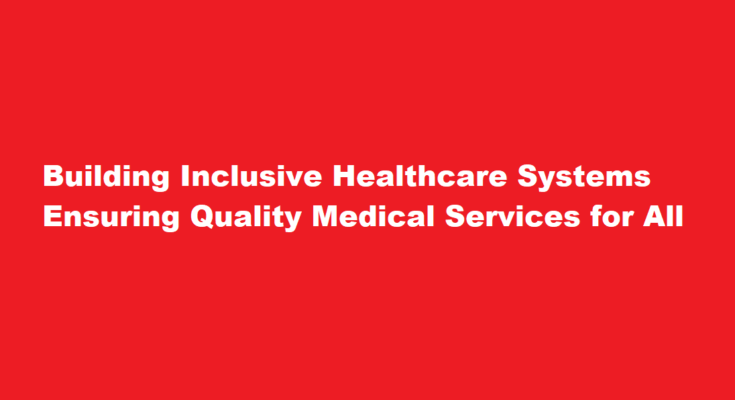Introduction
Access to high-quality healthcare is a fundamental human right. Yet, around the world, disparities in healthcare persist due to socioeconomic factors, leaving vulnerable populations at a disadvantage. Creating comprehensive and accessible healthcare systems that cater to all individuals, regardless of their socioeconomic status, is a complex endeavor that requires collaboration, policy changes, and innovative solutions.
Equitable Access to Basic Healthcare
To establish comprehensive and accessible healthcare systems, governments must prioritize universal healthcare coverage. This involves ensuring that every citizen has access to basic medical services without financial hardship. This can be achieved through tax-funded or insurance-based models. For instance, countries like Canada and the United Kingdom provide free healthcare at the point of service, funded through taxation. This approach eliminates financial barriers to care.
Addressing Socioeconomic Barriers
A holistic approach to healthcare accessibility involves addressing socioeconomic determinants of health, such as income, education, and housing. Healthcare systems should collaborate with other sectors to alleviate poverty and improve living conditions. For instance, offering affordable housing and educational opportunities can indirectly enhance health outcomes by reducing stressors linked to socioeconomic hardships.
Preventive Care and Public Health Initiatives
Shifting the focus from treatment-centric models to preventive care can significantly improve healthcare outcomes and reduce costs. Public health initiatives, including vaccination drives, health education campaigns, and early disease detection programs, can mitigate the burden on healthcare systems by curbing the prevalence of preventable illnesses.
Telemedicine and Digital Healthcare
Technology has the potential to bridge geographical gaps and improve healthcare access. Telemedicine, which allows remote consultations between patients and healthcare professionals, can be particularly beneficial for underserved rural or marginalized communities. Digital health solutions can also aid in tracking patient data and providing personalized care, ensuring that individuals receive the right interventions at the right time.
Community-Based Care
Establishing community health centers and clinics can bring healthcare closer to people, especially in remote or economically disadvantaged areas. These centers can provide a range of services, from primary care to mental health support, catering to the specific needs of the local population
Healthcare Workforce Development
A well-trained healthcare workforce is essential for providing high-quality medical services. Investing in training and education for healthcare professionals, especially those working in underserved areas, can improve the overall standard of care. Scholarships, incentives, and support for ongoing professional development can attract and retain skilled professionals where they are needed most.
Reducing Stigma in Healthcare
Stigma related to certain health conditions can prevent individuals from seeking care. Healthcare systems should prioritize creating non-discriminatory environments that respect the dignity of all patients. This includes promoting mental health awareness, addressing the stigma surrounding HIV/AIDS, and ensuring that marginalized groups, such as LGBTQ+ individuals, receive culturally competent care.
Transparent Healthcare Policies
Transparent and well-communicated healthcare policies help build trust among citizens. When people understand their rights and the services available to them, they are more likely to engage with the healthcare system. Governments should work on simplifying complex healthcare information and making it accessible to all, regardless of education or socioeconomic status.
International Cooperation and Knowledge Sharing
Countries can learn from each other’s successes and challenges in healthcare accessibility. International organizations and collaborations can facilitate knowledge exchange, helping nations adopt effective strategies and adapt them to their own contexts.
Advocacy and Public Participation
Civil society plays a crucial role in holding governments accountable for healthcare accessibility. Advocacy groups, NGOs, and community members can influence policy decisions, raise awareness about disparities, and push for changes that benefit marginalized populations.
FREQUENTLY ASKED QUESTIONS
What are the policy suggestions to improve healthcare accessibility and affordability in the country?
The National Health Policy recommends increasing the outlay – Centre and state combined – to 2.5%. It further recommends that state budgets increase health allocation 8% of the total budget. At the moment, all states except Delhi a lot less than 8%.
How accessible is healthcare in India?
Public healthcare is free for every Indian resident. The Indian public health sector encompasses 18% of total outpatient care and 44% of total inpatient care. Middle and upper class individuals living in India tend to use public healthcare less than those with a lower standard of living.
Conclusion
Creating comprehensive and accessible healthcare systems that provide high-quality medical services to all individuals, regardless of their socioeconomic status, is an ongoing process that requires political will, societal collaboration, and innovative thinking. By addressing socioeconomic determinants, prioritizing preventive care, embracing technology, and fostering an inclusive healthcare culture, societies can take significant steps toward achieving health equity. Ultimately, the goal is to build a future where everyone has the opportunity to lead a healthy life, unburdened by the constraints of their socioeconomic background.
Read Also : Ensuring Responsible and Safe Integration of Emerging Biotechnologies and Genetic Engineering



